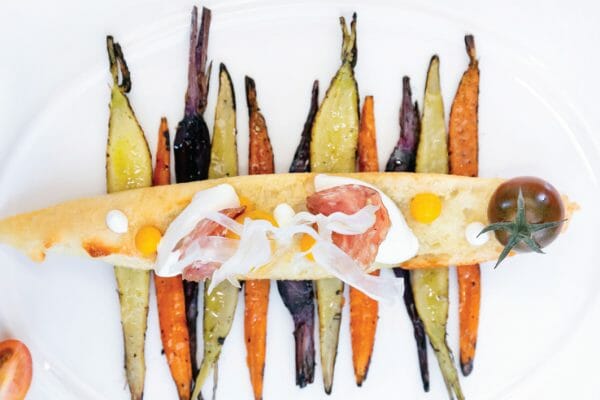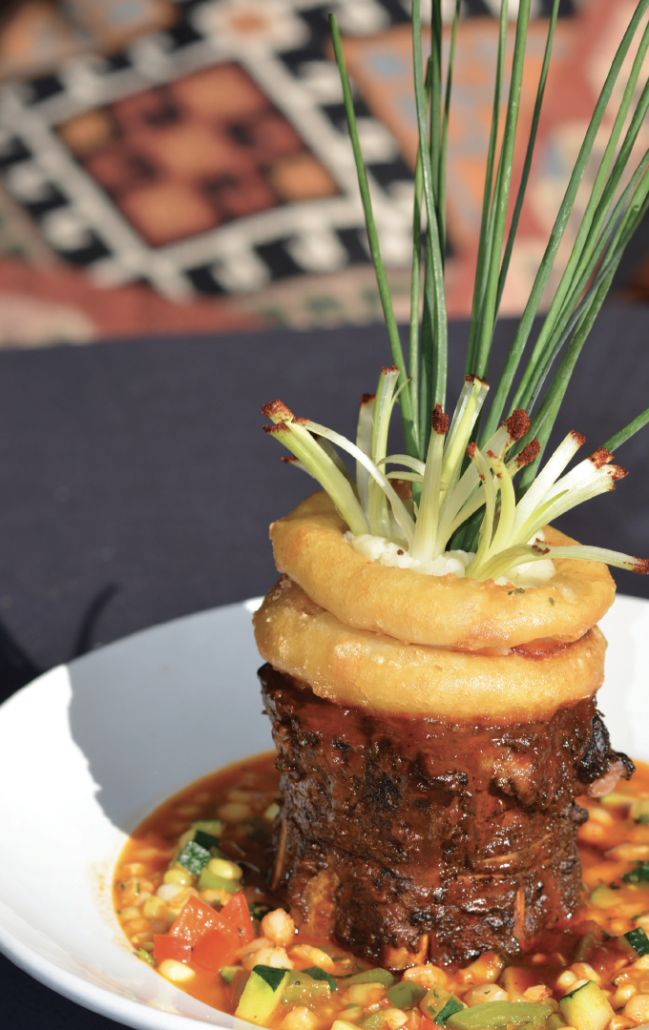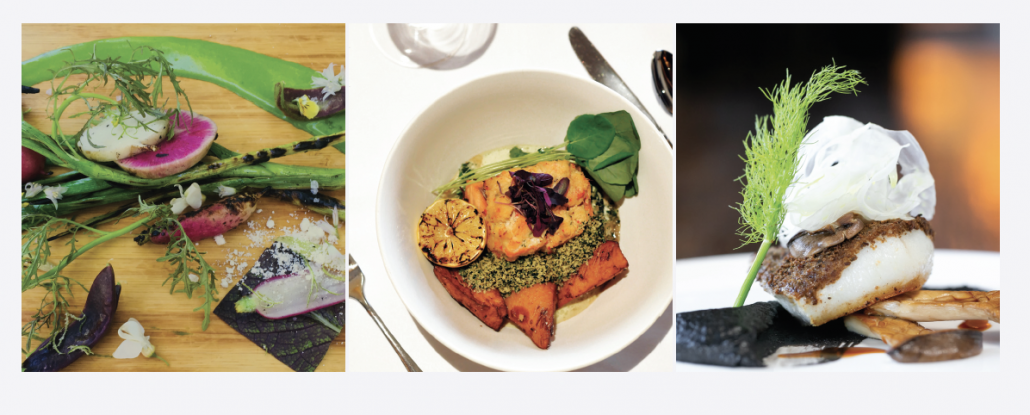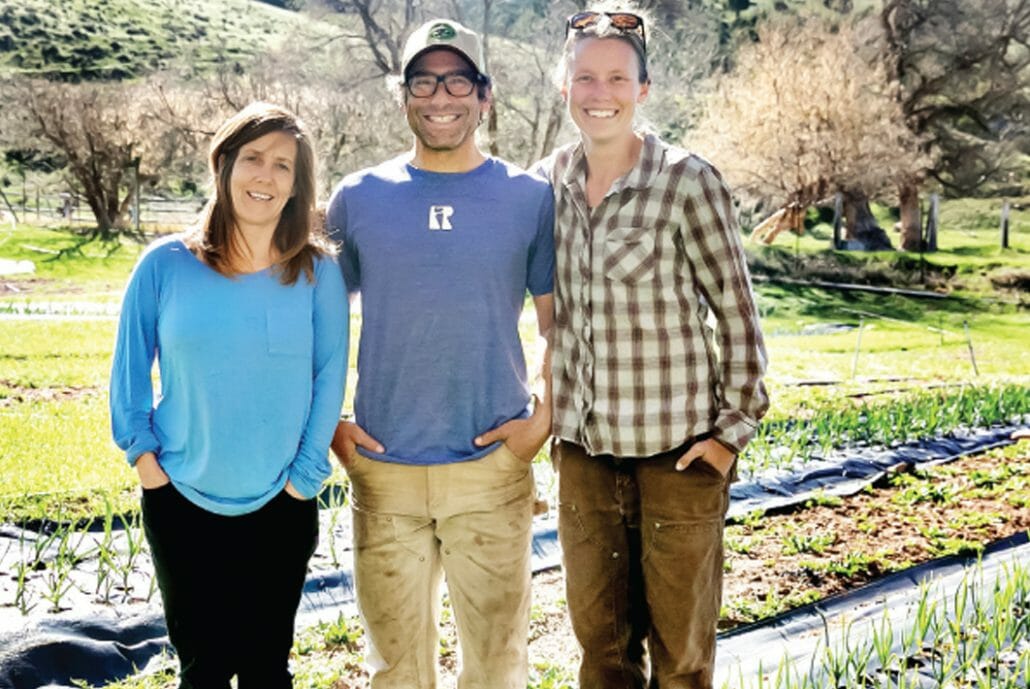
Edible Art
You eat with your eyes first
Written By: Ted Scheffler | Images: Coutsey of Chimayo, Glitretind, Handle, Hearth & Hill, Powder, Tupelo, and Wahso
YOU’VE PROBABLY HEARD THE WELL-KNOWN ADAGE THAT “YOU EAT WITH YOUR EYES FIRST.” FOR ME, THAT SAYING GOES HAND-IN-HAND WITH THIS ONE: “YOU ONLY GET ONE CHANCE TO MAKE A FIRST IMPRESSION.” AS A RESTAURANT CRITIC AND FOOD WRITER, THE FIRST IMPRESSION OF A CHEF’S FOOD IS WHAT I SEE ON THE PLATE OR IN THE BOWL. OF COURSE, I’M MOST INTERESTED IN HOW THE FOOD TASTES, BUT IF A DISH LOOKS UNAPPETIZING, THERE’S ALREADY AT LEAST ONE STRIKE AGAINST IT. SOME SCIENTISTS AGREE.
In a pointy-headed scientific paper called “You Eat with Your Eyes First,” published in the Physiology & Behavior journal, researcher Jeannine Delwiche writes that “While the senses of taste, smell, and vision are distinct, visual stimuli have been shown to alter the perception of taste, smell, and flavor.” In other words, if the food you’re about to eat looks like garbage, your other senses might be tricked into thinking it tastes like garbage.
But we’re not here to talk about ugly food. We’re here to talk about a “feast” for the senses, especially food that is prepared and presented with a visual wow factor. In other words, edible art. The chefs and restaurants selected for this article all have something in common: they are artists in the kitchen. Their culinary creations could be hung in galleries, if only they wouldn’t spill or expire.

Zane Holmquist is the talented vice president of food and beverage and the corporate chef at Stein Eriksen Lodge. He says, “I believe anticipation anticipation is the beginning of a meal. The visual aspect, along with the smell of the fire and aromas of turmeric and curry coming from the kitchen, lead to more anticipation as you read through the menu and select some dishes.”
If you’re lucky enough to select a dish from the Glitretind restaurant at Stein’s, like Holmquist’s Bison and Ahi Tartare, you’ll be treated to a visual experience before you ever take a bite. The same goes for his Farmer Jones White Rabbit Salad. They are beautiful presentations of food that are as delicious to look at as to eat.
Holmquist continues, “When you see the dish, the visual component, the artistry, the textures, and sense of space all kick in. Finally, the taste brings all of these senses together. To me, the art is not only in the visual aspect of the dish, it is creating the moment and the memories of that meal–all of the pieces come together to create a sense of art.”
Since opening in January, Hearth and Hill in Kimball Junction has been bowling over locals and tourists alike with seductive, artfully presented dishes like the irresistible Sundae Nachos dessert. The use of a neutral, cream-colored serving plate makes the smorgasbord of bold col-ors from the fruits, chocolate waffle, banana, hot fudge, and almonds jump from the dish.
“Just because you can serve food on a hubcap doesn’t mean you should.” - Bill White


In contrast to such a tempting dessert, Handle Chef-Owner Briar Handly beckons guests with his sensational Spring Green Salad. A melange of fresh greens with charred radishes, wild leeks, edible flowers, and nettle emulsion is served on a wooden board and is so visually enticing, I considered going vegetarian.
Wanna see some really eye-popping food presentations? Head over to Powder at the Waldorf Astoria. Austrian-born Executive Chef Hermann Schaeffer creates stunning examples of edible art. “The visual aspect of any plate is very, very important,” says Schaeffer. “I believe actually that you eat 90 percent with your eyes. I used to sketch all of my food on paper when I was creating a dish.” But now, with many years of restaurant experience, he says, “I can see in my mind when I’m cooking what the food is going to look like on the plate.” Gone are the sketchpads.
Schaeffer’s Duck Breast and Confit dish is positively mind-blowing; it doesn’t look like any duck I’ve ever encountered. A smear of pureed celery root on the plate contrasts with the pink and brown tones of lightly-seared duck breast and “deconstructed” duck confit, which is deboned, compressed, and cut into squares. And you should see what he can do with car-rots! The Marinated Grilled Carrots With Wild Boar Salami, Whipped Ricotta, and Caramelized Orange Vinaigrette is simply jaw-dropping.

For me, it was restaurateur Bill White who first introduced Park City to restaurants that created candy for the eyes. From his first establishments, Grappa, Chimayo, Windy Ridge, and Wahso, to more recent ones such as Ghidotti’s, Sushi Blue, Billy Blanco’s, and Bill White Farms, each and every eatery takes ambiance and artful surroundings very seriously.
And that goes double for what’s on the plate. The carefully chosen dinnerware is key to the memorable food presentations at White’s restaurants. But there’s also restraint involved in creating beautiful but functional food art. Billy Blanco’s is a gearhead’s dream restaurant, decked out with motorbikes, muscle cars, and general speed freak fodder. “But just because you can serve food on a hubcap doesn’t mean you should serve food on a hubcap,” White once told me.
And so, Wahso Executive Chef Rafael Zamora dishes up his vividly-hued Tofu and Vegetables entree on a charcoal-colored plate for maximum contrast and visual effect. Meanwhile, over at Chimayo, Executive Chef Arturo Flores reaches for the stars with his vertically challenging Crown Roast Barbeque Spareribs. It’s a beautiful thing.
One of the most exacting chefs I know is Matt Harris, owner and chef at Tupelo restaurant–a work of art itself. He’s very picky about using the freshest ingredients, treating them with love and care, and presenting his food to guests in a way that inevitably results in lots of photo taking and Instagramming.
Harris’ Roasted Maine Scallops with Purple Cauliflower, Romanesco, and Hazelnut Pesto looks damn near too pretty to eat. And his Goat Milk Ricotta appetizer is a stunning way to start a meal. Not to be outdone, Tupelo Pastry Chef Shirley Butler creates breathtaking dishes of her own, such as her delectably decadent Chocolate Peanut Butter Pot Au Creme With Banana. “We have great plates for showcasing our food,” says Butler, referring to a line of ceramic dishes that are made for them in Salt Lake City.
As a kid, I was always told not to play with my food. Lucky for us, these artful chefs never got that message.
